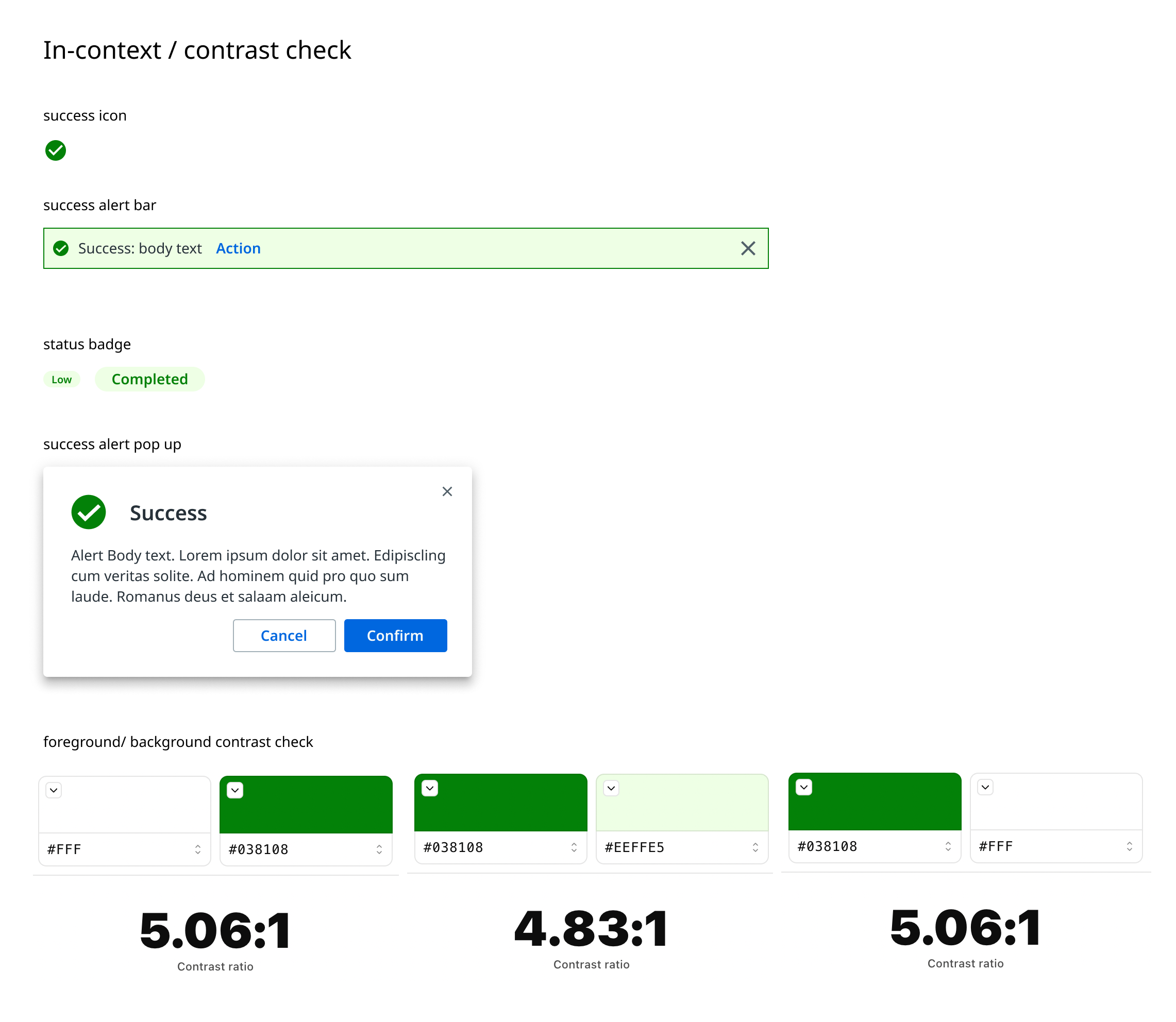Elevating user experience through increased accessibility across the UiPath Platform

In 1989, British scientist Tim Berners-Lee invented the World Wide Web. Over the next few years, he not only evangelized his creation but also was an early proponent of digital accessibility. Berners-Lee wrote about it in a 1996 newsletter:
“The emergence of the World Wide Web has made it possible for individuals with appropriate computer and telecommunications equipment to interact as never before. It presents new challenges and new hopes to people with disabilities.”
And today?
"An estimated 1.3 billion people—or 16% of the global population—experience a significant disability today,” according to the World Health Organization.
What started as a single web server created so researchers could quickly and easily share files with each other has morphed into an internet and smart technologies. Technologies that power our homes, vehicle systems, and large parts of our daily lives.
We’ve also seen first hand how artificial intelligence (AI) and automation can revolutionize how we interact with applications. UiPath is committed to breaking down barriers to create an AI-powered automation experience that's accessible to all users, regardless of physical or cognitive ability.
In today’s blog post, we’ll dive into product user experience (UX) accessibility and how UiPath is making the UiPath Business Automation Platform more accessible for all users.
Accessibility gains a renewed focus
Creating accessible software tools has always been a priority for companies, but it gained a new level of prominence post-pandemic. As work moved from the office to homes during COVID, organizations learned their tech stacks weren’t fully optimized for people with diverse abilities. In some areas, such as academics, “education institutions across the country and worldwide—had to quickly roll out and train instructors on both existing and new technologies.” Vendors within those tech stacks realized they needed to quickly improve their products with more accessible user experiences.
The International Association of Accessibility Professionals (IAAP) and Deque Systems conducted surveys in 2020 and 2021 to understand how COVID-19 affected digital accessibility. Seventy-three percent of respondents reported that “COVID-19 has raised the awareness and impact of accessibility on the digital channel.”
Fortunately, more companies are seeing that designing for accessibility is an opportunity. The opportunity to serve a broader audience, design with empathy, and innovate in ways that benefit everyone.
Identifying accessibility issues
Remember that Berners-Lee was advocating for improved web accessibility in the 1990s. So, Berners-Lee (and other early contributors to the web) created a global consortium, World Wide Web Consortium (W3C). The organization is dedicated to making the web more accessible to people with disabilities.
W3C provides internationally recognized guidelines—Web Content Accessibility Guidelines (WCAG)—that make aligning to accessibility standards very clear and straightforward for companies around the world. These guidelines not only ensure legal compliance, but also provide a roadmap to design software that’s perceptible, operable, and understandable for all users.
Product accessibility and user experience form a dynamic partnership, where accessibility lays the foundation for a seamless user journey, rather than just being a process of following requirements and ticking boxes.
Alexandra Maria Pop, Senior Manager Product Localization and Accessibility, UiPath
Which brings us to UX research. The UX research program at UiPath focuses on understanding users’ needs, insights, behaviors, barriers, and usability issues in our products.
Our design and product research studies and accessibility evaluations help us gain a deeper understanding of the challenges that specific users living with a disability (neurodiversity, mobility, visual, and hearing) face while using the UiPath Business Automation Platform.
Raluca Maxim, Senior Design Researcher and UX Research Program Lead, UiPath
UiPath Accessibility team members work with developers and designers to ensure that accessibility features are considered early in the product’s lifecycle.
We understand that making our products more accessible isn’t a one-time task—it’s an ongoing effort that requires input from all our stakeholders to ensure we get it right. We’re proud of the progress we’ve made thus far and are excited about what we have planned for the future.
How UiPath is improving the accessibility of our products
Our commitment to accessibility is intrinsic to our broader mission of democratizing automation, which is enabled by a suite of no- and low-code tools available via The UiPath Business Automation Platform. Regardless of an employee’s technical skills, background, or abilities, putting automation in the hands of more users means more great ideas bubbling to the surface.
Companies with a mature automation profile recognize that incorporating automation at the beginning of a product’s lifecycle, rather than at the final stages, creates optimal outcomes. Likewise, we’re weaving accessibility considerations into our design and engineering processes from the start, rather than simply checking an accessibility box right before launch.
These processes are managed and refined by the UiPath Product Accessibility team, led by Pop. The three-person team also includes:
Robert Trandafir, Accessibility Senior Product Program Manager
Andrei Begu, Accessibility Program Manager
Here’s some of my conversation with Pop:
"Three years ago, when I first started building the Accessibility team, the concept of product accessibility was entirely unfamiliar to me. Since then, it has been an ongoing learning experience, encompassing a range of aspects such as understanding accessibility principles, conducting audits, fostering a shift in mindsets, and embracing users’ and customers’ feedback.
Throughout this journey, I've had the privilege of working alongside dedicated program managers, Andrei Begu and Robert Trandafir, who consistently advocate for our users, even in the face of challenges. The pursuit of enhanced accessibility across our UiPath Platform has also brought our product and engineering teams closer together, as we collectively share the lessons we've learned while improving product accessibility from one release to another."
A special ‘thank you’ to Pop and her team for their work. The passion they bring for improving accessibility across the UiPath Platform has also further unified product and engineering teams, who enjoy sharing lessons learned while improving product accessibility. And the collaboration with the Design team managed by Michael McCormack has created a standardized way of designing and developing user interfaces across our products.
What we’ve done
Here’s a brief look at some of the UiPath initiatives to improve accessibility:
Redesigned our color palette
To abide by the WCAG level AA contrast ratio of at least 4.5 to 1, we’ve adjusted colors and text sizes in our software interfaces to ensure clear visibility and readability for users with visual impairments.

Screen reader compatibility
Our engineering teams have made significant improvements in making our products compatible with screen readers. These assistive technologies convert on-screen information into speech, allowing users with visual impairments to interact with the software. One UiPath user who is totally blind was accepted into a bootcamp with the intention to learn to use UiPath Studio with the help of a screen reader.
Keyboard navigation
Whether they have a permanent or temporary disability (such as a new mother holding an infant), many users are unable to use a mouse or touchscreen. They rely solely on a keyboard to navigate digital tools. We’ve optimized our software for keyboard-only use, including features to skip to the main content on a page. This makes our products accessible to those with motor disabilities and anyone who prefers using the keyboard for navigation.

What we’re working on
While we’ve made significant progress, we have plenty more accessibility improvements planned.
Accessibility mode for the UiPath Platform
We’re working on adding accessibility mode as a feature across the UiPath Business Automation Platform.
Contextual cues
Contextual cues, such as auditory and textual prompts, serve as crucial aids for individuals with visual impairments, facilitating their navigation through our products. Such cues offer immense value not only to those with visual challenges, but also to neurodiverse individuals.
User testing sessions
Getting direct feedback is incredibly valuable and we'll be working more closely with UiPath users with differing abilities in user testing sessions. The feedback directly informs our product improvements (which can include improvements beyond accessibility standards).
In the process of making our products more accessible, this collaboration improves overall UX quality across the UiPath Platform.
If you would like to be part of future user testing sessions, please contact us directly at accessibility@uipath.com.
UiPath is committed to creating a more accessible digital world
Democratizing automation is core to our mission at UiPath. Besides making our customers more efficient and competitive, doing so extends the incredible power of this technology to all users. We’re committed to breaking down barriers in order to create an AI-powered automation experience that’s accessible to everyone—of all backgrounds and abilities.
Accessibility is a journey, not a destination, and we’re glad to walk this path with our customers, partners, and users. We invite you all to join us as we continue to learn, innovate, and make strides towards a more accessible digital world.

Editorial Director, Corporate Blog, UiPath
Get articles from automation experts in your inbox
SubscribeGet articles from automation experts in your inbox
Sign up today and we'll email you the newest articles every week.
Thank you for subscribing!
Thank you for subscribing! Each week, we'll send the best automation blog posts straight to your inbox.



